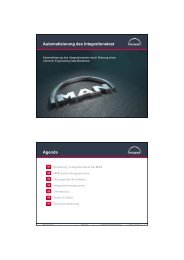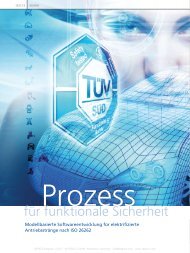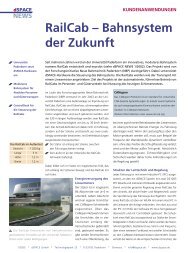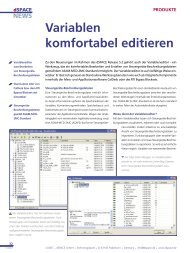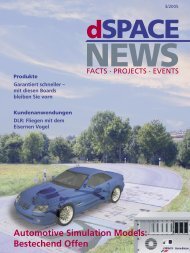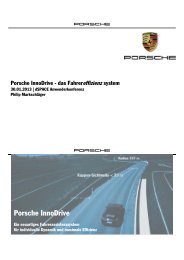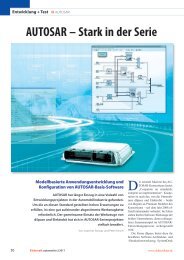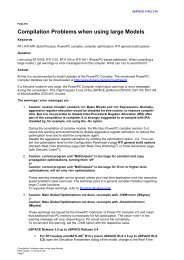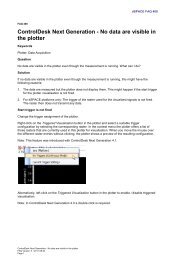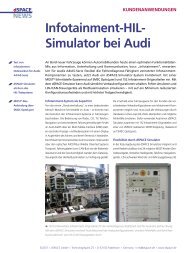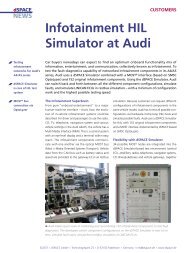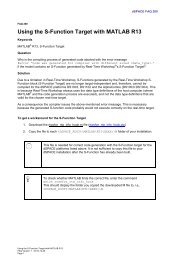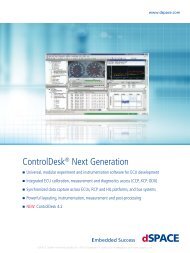magazinE - dSPACE
magazinE - dSPACE
magazinE - dSPACE
Create successful ePaper yourself
Turn your PDF publications into a flip-book with our unique Google optimized e-Paper software.
pAGe 50 dSpACe’S 20TH ANNIveRSARY<br />
ming. Therefore an automatic code<br />
generator and a couple of associated<br />
tools were quickly developed. This<br />
processor passed its first reallife test<br />
in a Mercedes bus with electronic<br />
lane keeping. After numerous further<br />
developments and successful applications,<br />
we had the idea of producing<br />
something similar commercially<br />
for worldwide use. Three colleagues,<br />
involved in this university project in<br />
different functions, and I founded<br />
<strong>dSPACE</strong> GmbH in 1987, and on<br />
January 2, 1988 we started work on<br />
developing an almost completely<br />
new toolset.<br />
What obstacles did you face when<br />
starting the company?<br />
The knowhow was there, but the<br />
products we wanted to market still<br />
had to be developed. One year<br />
was scheduled for developing the<br />
first toolset – a year in which there<br />
The starting point for further developments:<br />
A test bench used by the University of<br />
Paderborn in the 1980s for research on<br />
mechatronic control systems. Among other<br />
things, it was the basis for the active wheel<br />
suspensions used in today’s vehicles.<br />
“ The gist of Professor Leonhards evaluation<br />
was: If they don’t try to do too many things at<br />
once, it might work.”<br />
would be no sales. Fortunately,<br />
loans and subsidies were available<br />
for such cases. To obtain these, we<br />
needed more than just brilliant<br />
ideas.<br />
We had to convince people that our<br />
plans were viable. So one of the<br />
things we did was to acquire statements<br />
on our chances of success<br />
from people who were specialists in<br />
the field and seemed unbiased. The<br />
appraisal given by Professor Leonhard<br />
from Braunschweig, a worldrenowned<br />
electrical drives specialist,<br />
was critical in a positive way. The<br />
gist of his conclusion was, “If they<br />
don’t try to do too many things at<br />
once, it might work.”<br />
What products did it all begin with,<br />
and for what applications?<br />
The hardware consisted of boards<br />
with a signal processor from Texas<br />
Instruments – which in those days<br />
Dr. Herbert Hanselmann<br />
still used fixedpoint arithmetics – and<br />
several I/O boards dedicated to control<br />
engineering. The software was a<br />
toolset for preparing and simulating<br />
state controllers and generating<br />
code in DSPL, a language that we<br />
defined ourselves and which we also<br />
wrote the compiler for. We placed<br />
great importance on optimal machine<br />
code: “C” was not an option.<br />
Who were the first customers?<br />
Philips is one I remember. Their<br />
Manufacturing Technology Center<br />
had a load of unsolved control tasks,<br />
including one for wafer steppers<br />
with a positioning precision of nanometers.<br />
One particularly unexpected<br />
customer was Hilti from Liechtenstein,<br />
known all over the world as a<br />
manufacturer of highquality rock<br />
drills. They also did an astonishing<br />
amount of mechatronics. Basically,<br />
our first customers were engineers<br />
who lacked the means to implement<br />
fast controllers quickly, just like us a<br />
few years previously.<br />
What was the most interesting<br />
project with <strong>dSPACE</strong> tools at that<br />
time?<br />
That’s a difficult question, there were<br />
so many, including really exotic ones<br />
like the control system for<br />
hydraulically shifted masses used as<br />
earthquake dampers at the top of<br />
skyscrapers in Japan. Walt Disney<br />
needed our equipment to control<br />
one of their theme park attractions.



